Figure 5.
MamK polymers assembled into bundles in a salt-dependent manner. (A) The efficiency of MamK filament polymerization in different salt concentrations. The percent ratio of MamK filaments in the total protein represents the polymerization efficiency. Results are given as the mean ± SD (n = 4). Different letters indicate significant differences among the various concentrations of salt (Duncan’s multiple range test, P < 0.05). (B) Single MamK filaments were observed in the absence of salt. (C and D) MamK filaments formed in KCl and NaCl at concentrations ranging from 20 to 200 mmol/L. The formation of single filaments was observed in the presence of 20 mmol/L KCl or NaCl, and filaments with a well-ordered structure were observed with NaCl. MamK filaments preferentially clustered to form bundles in the presence of increasing KCl or NaCl concentrations ranging from 50 to 200 mmol/L. The insets show high magnification images. The 500 nm and 50 nm scale bars are shown in the low and high magnification images, respectively

